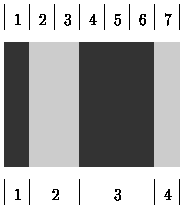 |
| ||||
Home Page
F.A.Qs
Statistical Charts
Past Contests
Scheduled Contests
Award Contest
| ||||||||||
| Online Judge | Problem Set | Authors | Online Contests | User | ||||||
|---|---|---|---|---|---|---|---|---|---|---|
| Web Board Home Page F.A.Qs Statistical Charts | Current Contest Past Contests Scheduled Contests Award Contest | |||||||||
|
Language: Bar Codes
Description A bar-code symbol consists of alternating dark and light bars, starting with a dark bar on the left. Each bar is a number of units wide. Figure 1 shows a bar-code symbol consisting of 4 bars that extend over 1+2+3+1=7 units.

Figure 1: Bar-code symbol over 7 units (see top) with 4 bars (see bottom) In general, the bar code BC(n,k,m) is the set of all symbols with k bars that together extend over exactly n units, each bar being at most m units wide. For instance, the symbol in Figure 1 belongs to BC(7,4,3) but not to BC(7,4,2).
Figure 2 shows all 16 symbols in BC(7,4,3). Each `1' represents a dark unit, each `0' a light unit. The symbols appear in lexicographic (dictionary) order. The number on the left of the colon (`:') is the rank of the symbol. The symbol in Figure 1 has rank 4 in BC(7,4,3). Input Your program is to read from standard input. The first line contains the numbers n, k, and m (1 <= n,k,m <= 33). On the second line is a number s (0 <= s <= 100). The following s lines each contain some symbol in BC(n,k,m), represented by '0's and '1's as in Figure 2. Output Your program is to write to standard output. On the first line your program should write the total number of symbols in BC(n,k,m). On each of the s following lines, it should write the rank of the corresponding symbol in the input. Sample Input 7 4 3 5 1001110 1110110 1001100 1001110 1000100 Sample Output 16 4 15 3 4 0 Source |
[Submit] [Go Back] [Status] [Discuss]
All Rights Reserved 2003-2013 Ying Fuchen,Xu Pengcheng,Xie Di
Any problem, Please Contact Administrator